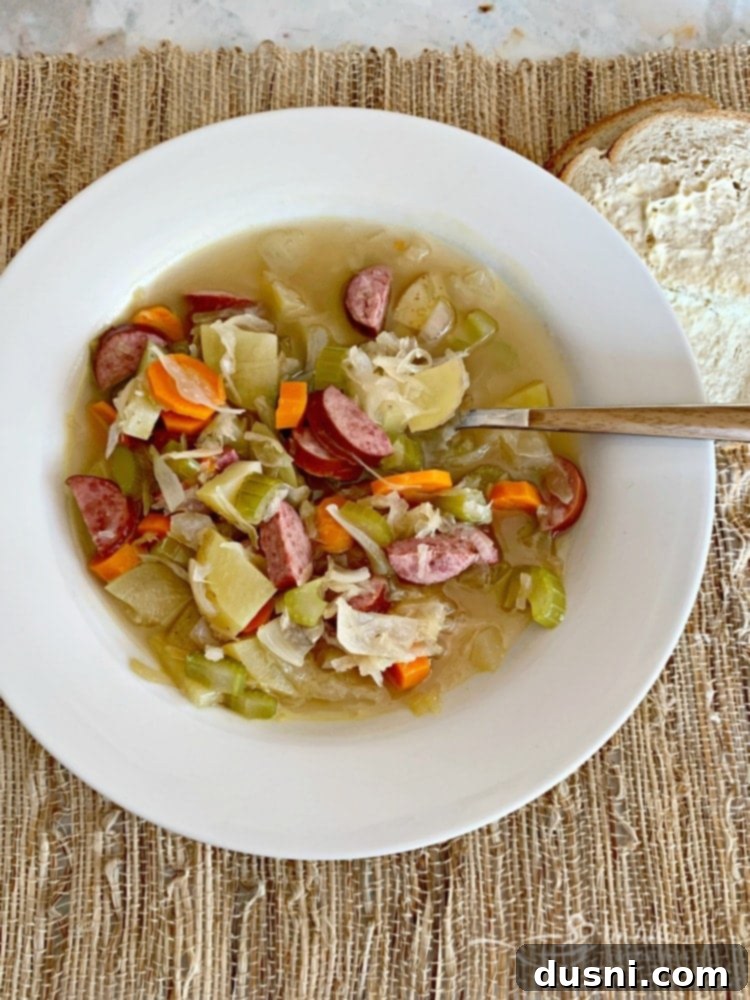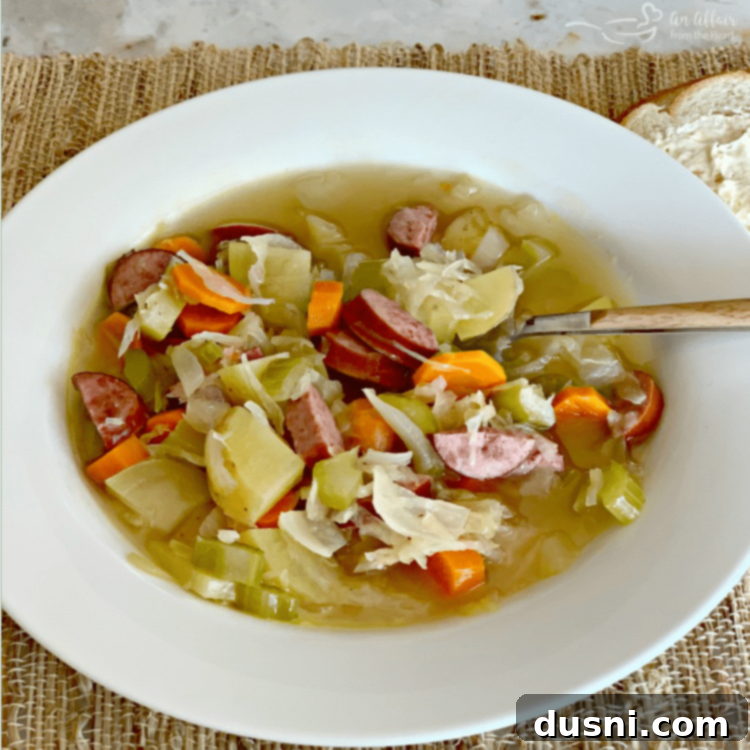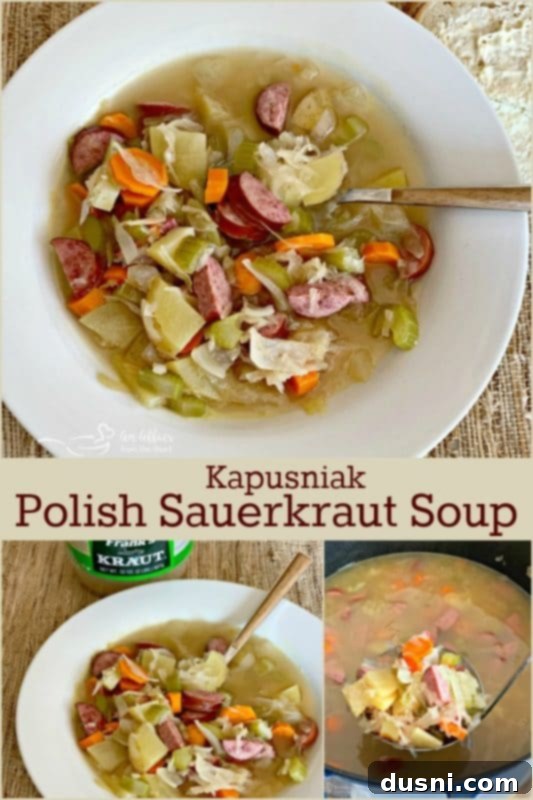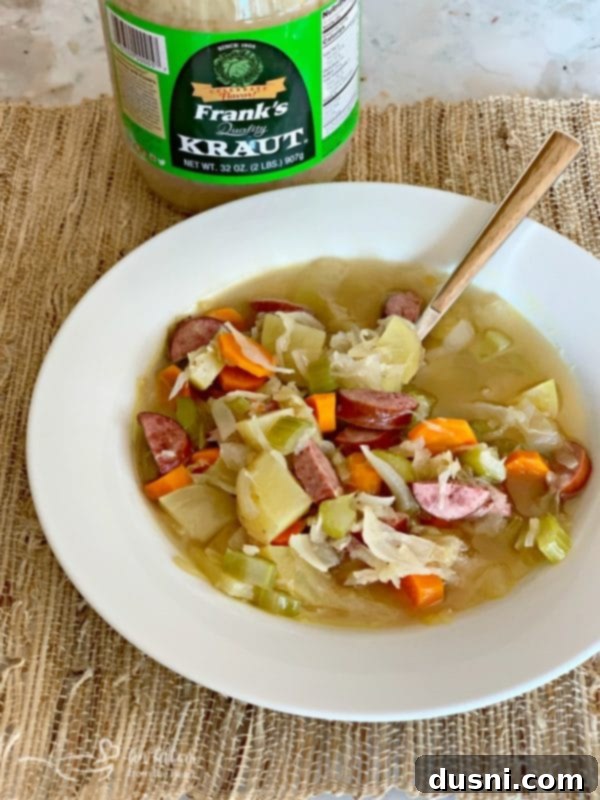Authentic Polish Sauerkraut Soup (Kapusniak): A Heartwarming Family Recipe
Kapusniak holds a very special place in my heart, deeply rooted in my Polish heritage. This traditional Polish Sauerkraut Soup is more than just a meal; it’s a labor of love and a cherished family tradition passed down through generations. The rich, complex flavors of this soup evoke memories of cozy kitchens and family gatherings, making it a true comfort food staple in our home.

While there are countless regional variations of this beloved Polish Sauerkraut Soup, some made with vegetable stock, others with chicken or even pork broth, and using either fresh cabbage or fermented sauerkraut, my personal rendition leans into the robust flavors I grew up with. I craft my Kapusniak using rich sauerkraut and savory Polish sausage, creating a uniquely “hot & sour” experience that perfectly embodies the heart of Polish culinary tradition. This combination creates a deeply satisfying and flavor-packed soup that’s both tangy and savory, perfect for chilly days.
This post is sponsored by Frank’s Kraut, but my lifelong love of their sauerkraut and opinions in this post are all my own.
SOME OF THE ITEMS BELOW CONTAIN AFFILIATE LINKS; I AM A PARTICIPANT IN THE AMAZON SERVICES LLC ASSOCIATES PROGRAM, AN AFFILIATE ADVERTISING PROGRAM DESIGNED TO PROVIDE A MEANS FOR US TO EARN FEES BY LINKING TO AMAZON.COM AND AFFILIATED SITES. I AM ALSO AN AFFILIATE FOR OTHER BRANDS. HOWEVER, I ONLY PROMOTE THINGS THAT I LOVE AND THINK YOU WILL LOVE, TOO. FOR MY ENTIRE DISCLOSURE POLICY PLEASE CLICK HERE.
Understanding Kapusniak: The Heart of Polish Cuisine
Kapusniak, pronounced “Kah-Pus-Knee-Ack,” is a staple in Polish cuisine with a rich history. Traditionally, it was often prepared as a vegetarian soup, especially during Lent, when meat consumption was restricted. However, over time, regional preferences and family traditions have evolved, leading to a wide array of delicious variations. This particular recipe is my unique take, born from years of trying different styles and perfecting a version that truly resonates with my family’s tastes and my Polish roots. It’s the recipe that consistently brings warmth and joy to our dinner table.
Why My Kapusniak Recipe Shines: Chicken Broth and Hearty Polish Sausage
There’s something universally comforting about a bowl of chicken soup, a dish found in almost every culture worldwide. It’s especially welcome as the weather turns chilly, offering a warmth that nourishes both body and soul. My version of Kapusniak leverages this inherent comfort by featuring a robust chicken broth, which provides a flavorful foundation that complements the tanginess of the sauerkraut beautifully.
This sauerkraut soup truly embodies the essence of old-world traditions. Historically, Kapusniak was often prepared in the crisp autumn and winter months, a time when sauerkraut had fully fermented, reaching its peak flavor. Imagine a cool, rainy day, the kitchen filled with the inviting aroma of simmering Kapusniak. A warm bowl, perhaps with a thick slice of rye bread for dipping, is nothing short of divine. The combination of savory broth, tender vegetables, and the distinct taste of sauerkraut creates a truly heartwarming experience, making it an ideal meal to share with loved ones.
Exploring the Diverse World of Kapusniak Variations
Indeed, Kapusniak is a wonderfully versatile dish with numerous regional styles and interpretations across Central and Eastern Europe. While the basic concept revolves around cabbage or sauerkraut, the specifics can vary greatly, offering a fascinating glimpse into local culinary preferences.
For instance, in Czech cuisine, the soup (often called Zelňačka) typically features fresh cabbage, while Poles, with their deep appreciation for fermentation, overwhelmingly favor the sharp, complex flavor of sauerkraut. These regional differences are not just about taste; they often reflect historical agricultural practices and the availability of ingredients. Both meat and vegetarian versions exist, catering to different dietary needs and traditions. Some recipes proudly include hearty potatoes for added substance and comfort, while others omit them for a lighter soup or to cater to low-carb preferences.
Despite these variations, the core elements remain consistent: a flavorful stock combined with cabbage or sauerkraut and other wholesome vegetables, resulting in a healthy and incredibly satisfying soup. For my personal recipe, I find that chicken stock provides the perfect light yet flavorful base, beautifully complementing the rich notes of authentic Polish sausage, making it a truly exceptional meal.
Frank’s Kraut: The Secret to Perfect Kapusniak!
Choosing the right sauerkraut is crucial for an exceptional Kapusniak. While many varieties are available, I consistently turn to Frank’s Kraut for all my kraut-based dishes. My kitchen is well-stocked with a plethora of sauerkraut recipes, and Frank’s Kraut is always my preferred choice.
What makes Frank’s Kraut so ideal for this Polish Sauerkraut Soup? Its exceptional quality ensures that it holds up beautifully during cooking, retaining a delightful crunch and texture. There’s nothing worse than sauerkraut that disintegrates into the soup, losing its characteristic bite. Frank’s Kraut maintains its integrity, adding that essential textural contrast and robust flavor.
A key tip for preparing Kapusniak with canned or jarred sauerkraut is to rinse it thoroughly under cool water before adding it to the soup. This simple step helps to wash away some of the excess saltiness from the brine, allowing the sauerkraut’s inherent tangy and complex flavors to truly shine without overpowering the dish. Don’t worry, you’ll still have plenty of that distinctive kraut taste!
Are you fascinated by the world of fermented foods? Do you crave more knowledge about this ancient and delicious ingredient? Dive deeper into everything you’ve ever wanted to know about kraut! Discover where it comes from, how it’s traditionally made, and explore tons of exciting sauerkraut recipes in my comprehensive Ultimate Guide to Sauerkraut.
The Ultimate Guide to Sauerkraut – A complete guide to everything you need to know about sauerkraut or kraut, including information on different variations and regional traditions, is an invaluable resource for any kraut enthusiast.
The Health Benefits of Sauerkraut and Chicken Soup
Kapusniak isn’t just a delicious and comforting meal; it’s also packed with remarkable health benefits, a fact recognized by both ancient folk traditions and modern nutritional science. Sauerkraut, the star ingredient, is a nutritional powerhouse. It’s an excellent source of dietary fiber, promoting healthy digestion and gut flora. Rich in vitamins A and C, and brimming with beta-carotene, sauerkraut is essentially a food designed by nature to boost your immune system and help ward off common colds and illnesses. Its fermentation process also introduces beneficial probiotics, which are vital for a healthy gut microbiome, contributing to overall well-being.
When combined with a wholesome chicken stock, the health benefits of Kapusniak are amplified. Chicken stock is widely known for its anti-inflammatory properties, providing soothing relief, especially when you’re feeling under the weather. The warmth of a hot soup, in general, offers comfort and helps clear congestion. So, by combining the immune-boosting power of sauerkraut with the healing qualities of chicken stock, you’re not just enjoying a hearty meal; you’re fueling your body with a potent cold-fighter. This soup truly is a delicious remedy for those chilly, sniffly days, making you feel good from the inside out.
Selecting the Perfect Sausage for Your Kapusniak
Given that this is an authentic Polish Sauerkraut Soup featuring sausage and kraut in a savory chicken broth base, it’s essential to honor its heritage with a proper Polish sausage! We’re talking, of course, about Polska Kielbasa. Kielbasa is the quintessential traditional style of Polish sausage, renowned for its rich flavor and satisfying texture.
In the United States, kielbasa is typically found in long, spiraling links, primarily made with pork and often smoked. However, in Poland, sausage-making is an art form, and Poles take their sausages very seriously, boasting an incredible array of varieties. Each type offers a unique flavor profile and texture, making the world of Polish sausage truly diverse and exciting.
- Kabanosy: These are slender, air-dried sausages, often compared to an American hot dog in shape, but with a distinct, smoky flavor enhanced by caraway seeds. They are typically made from pork and are perfect for snacking or adding a chewy texture.
- Krakowska: Hailing from Kraków, this is a thick, short, and intensely smoked sausage, seasoned with pepper and garlic. It’s known for its robust flavor and firm texture, ideal for slicing and serving.
- Kiełbasa Biała (White Sausage): A fresh, unsmoked sausage, usually made from veal and bacon. It’s lighter in color and flavor than smoked varieties and is frequently used in traditional Polish soups, including some Kapusniak variations, or boiled and served with horseradish.
- Kiełbasa Odesskie: A much thicker, bratwurst-style sausage, traditionally made with beef. It offers a heartier bite and a different flavor profile compared to pork-based kielbasa.
- Wiejska (Farmhouse Sausage): Also known as “farmhouse sausage,” this blend of pork and veal is characterized by its aromatic notes of marjoram and garlic. It’s lighter in color than smoked varieties but incredibly rich in flavor, reflecting rustic, homemade traditions.
- Kiełbasa Wędzona (Smoked Sausage): This is the style most Americans commonly associate with “Polish sausage.” It’s a smoked pork sausage, versatile and flavorful, and often the top choice for soups like Kapusniak due to its pre-cooked nature and deep smoky taste.
- Kiszka (Blood Sausage): A distinct blood sausage, dark in color and incredibly rich in flavor, often containing buckwheat or barley. While not typically used in Kapusniak, it’s an important part of Polish sausage tradition.
- Myśliwska (Hunter’s Sausage): Another style of smoked pork sausage, similar to a smoked bratwurst, known for its hearty texture and blend of spices, often enjoyed on its own or with hearty bread.
If you’re eager to find any of these more specialized styles of Polish sausage for your Kapusniak, you might discover them at the deli counter of a well-stocked local market. However, for the true authentic experience, I highly recommend seeking out one of those charming small European markets, often tucked away in strip malls. You know, the one you always drive by, promising yourself you’ll visit someday? That’s precisely where you’re likely to uncover an amazing, authentic variety of Polish-style sausages that will elevate your Kapusniak to an unforgettable culinary adventure. Finding such a gem is a real score for any food enthusiast!
Essential Ingredients for My Polish Sauerkraut Soup (Kapusniak)
Crafting a truly flavorful Kapusniak begins with selecting quality ingredients that contribute to its rich, hearty profile. Here’s what you’ll need for my family’s favorite version:
- Frank’s Kraut (rinsed and drained for optimal flavor balance)
- Polska Kielbasa (preferably smoked, for convenience and depth of flavor)
- Fresh vegetables: crisp carrots, crunchy celery, earthy potatoes, and aromatic onion
- Good quality olive oil for sautéing
- Flavor enhancers: a bay leaf for herbal notes, and caraway seeds for that classic Eastern European touch
- Salt & freshly ground black pepper, seasoned to your preference
- Chicken stock (provides a rich, savory base)
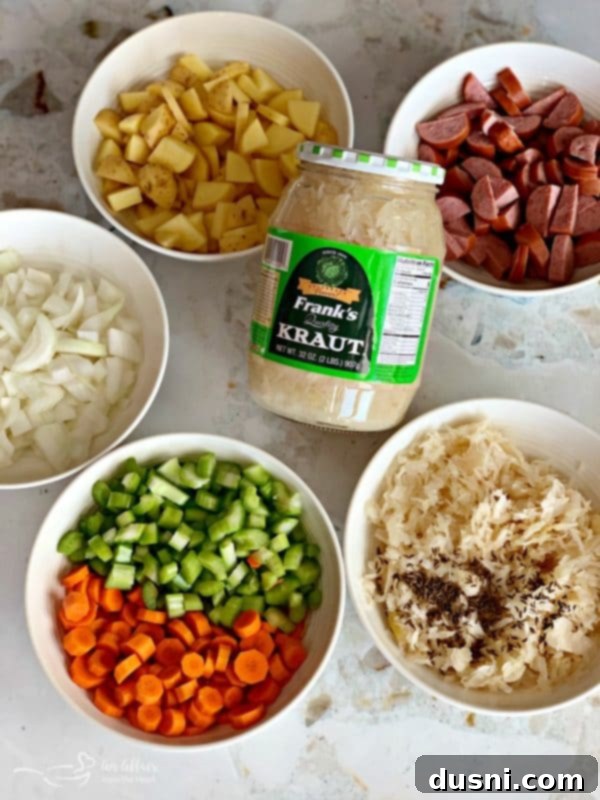
As I mentioned earlier, while I adore the addition of Polska Kielbasa for its incredible flavor and heartiness, its inclusion is entirely optional. Historically, Kapusniak began as a humble vegetarian soup, frequently enjoyed during the fasting period of Lent. If you’re looking for a meat-free option, simply omit the sausage, and you’ll still have a deeply satisfying and traditional soup.
A crucial step for achieving the perfect balance of flavors is to rinse your kraut thoroughly with cool water and then drain it well. This process removes some of the brine’s excess saltiness, preventing the soup from becoming overly salty while preserving all that delicious sauerkraut taste. I’m also a big fan of caraway seeds in this recipe. They add an authentic, earthy aroma and a subtle anise-like flavor that truly elevates the dish. While optional, if you appreciate their unique character, I highly recommend tossing them in!
The potatoes, too, offer a choice. Their starchy presence adds a wonderful heartiness and body to the soup, making it a more filling meal. However, if you’re aiming for a low-carb option, feel free to leave them out. The soup will still be incredibly flavorful and satisfying. Each ingredient offers flexibility, allowing you to tailor this classic recipe to your family’s preferences.

To begin, in a sturdy Dutch oven or large pot, heat your olive oil over medium-high heat. Add the bay leaf and diced onion, sautéing them gently until the onion becomes translucent and fragrant, typically about 5 minutes. This step builds a foundational layer of flavor for your soup. Next, incorporate the sliced Polish sausage. I always opt for pre-smoked kielbasa, which means it’s already cooked, requiring only a quick sauté to warm through and release its savory oils. Give it a good stir, allowing the flavors to meld, then add your rinsed and drained kraut and caraway seeds (if using). Let this mixture cook for a few more minutes, stirring occasionally, allowing the kraut to slightly soften and absorb the delicious sausage flavors.
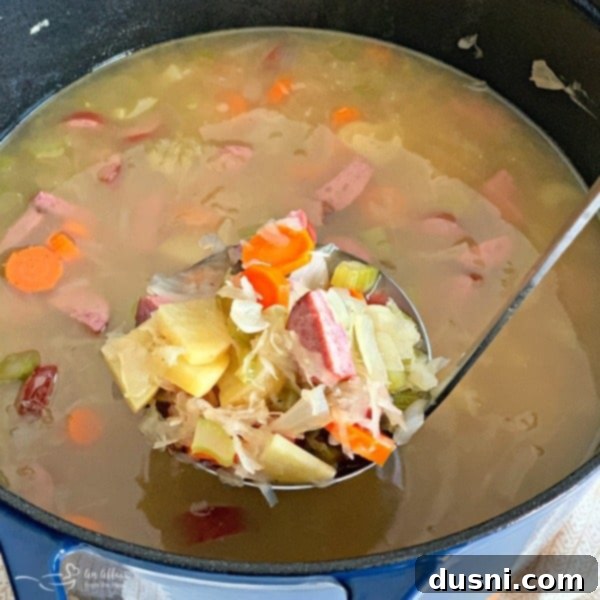
Now it’s time to bring all the elements together. Stir in the remaining chopped vegetables—carrots, celery, and diced potatoes—and add your chosen spices, but hold off on the salt for now, as the kraut and sausage already contribute a good deal of salinity. Pour in the chicken stock, ensuring all the ingredients are well submerged. Bring the soup to a gentle boil, then reduce the heat to medium-low, cover the pot, and let it simmer for about 30 minutes. This allows the vegetables to become tender and the flavors to fully develop and deepen, creating a truly harmonious blend. Cook until the veggies reach your desired tenderness. Once cooked, taste and adjust the seasoning with salt and pepper as needed. Serve this hearty Kapusniak hot, ideally with a thick slice of fresh rye bread for dipping, which perfectly complements the soup’s robust flavors.

It has been an absolute pleasure to partner with Frank’s Kraut over the past few years, developing countless delicious sauerkraut recipes. I want to take a moment to express my sincere gratitude to them for reaching out and giving me the opportunity to create for such a wonderful brand!
Side note: I’m absolutely thrilled with the cool new t-shirt they sent me, so I just had to include a “Frank’s Kraut Selfie” in this post! (And for those who frequently ask, no, I don’t wear colored contacts—this is my natural eye color!)
Frank’s Kraut has a remarkable legacy, proudly in business since 1905. Located in Ohio, they play a vital role in their community, supporting and employing many local cabbage farmers. This dedication to supporting local agriculture and “taking care of their own” deeply resonates with me, aligning perfectly with my own values. It truly is an honor to collaborate with a company that upholds such strong community ties and a century-long tradition of quality.
Don’t miss out on more delicious recipes and kraut inspiration! Follow along with Frank’s Kraut on their social media channels all year long. You can find them on Facebook, Twitter, Pinterest, and Instagram for everything sauerkraut!
If you’re having trouble finding Frank’s Kraut at your local grocery store, don’t worry! You can conveniently order it directly from their website or purchase Frank’s Kraut on Amazon, ensuring you always have this essential ingredient on hand.
Explore ALL of My Sauerkraut Recipes Here!
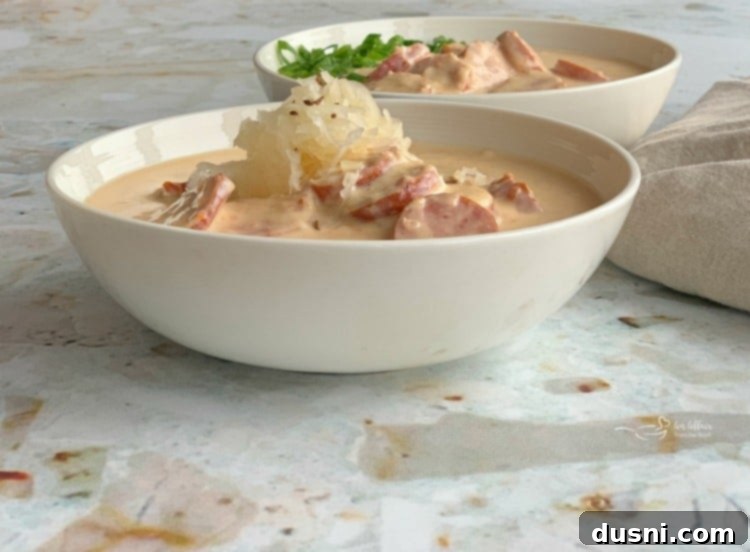
Sauerkraut is truly one of my most cherished ingredients, and I’ve incorporated it into a multitude of other delicious soups. Its ability to add a unique, tangy depth of flavor that you simply can’t achieve with any other ingredient is remarkable. Beyond its distinct taste, sauerkraut also contributes a wealth of health benefits, including vital probiotics and vitamins, making it a fantastic addition to almost any soup for both flavor and wellness.
Discover More Sensational Sauerkraut Soup Recipes:
- Cream of Reuben Soup: A rich and creamy soup inspired by the classic sandwich.
- Oktoberfest Chili: A hearty chili with a German twist, featuring kraut for an unexpected tang.
- Homemade Chicken Noodle Soup with Sauerkraut: A comforting classic elevated with the unique flavor and health benefits of kraut.
- Instant Pot Beer Cheese Soup with Kraut & Kielbasa: A quick and flavorful soup packed with savory goodness.
- Sauerkraut, Bratwurst and Potato Soup: A robust and filling soup that combines traditional German flavors.
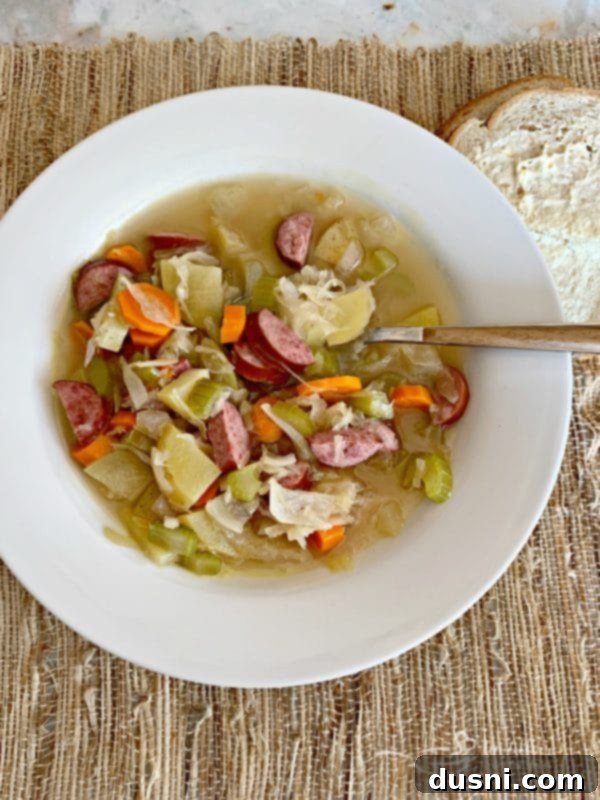
I truly hope you enjoy this Kapusniak recipe as much as I do. It’s the kind of simple, yet profoundly delicious dish that effortlessly transcends generations, carrying with it a legacy of flavor and tradition. While it’s wonderful anytime, there’s an undeniable magic to a warm bowl of Kapusniak on a cool, damp day—it truly tastes especially good when the weather outside is brisk and invitingly chilly. This soup is a testament to the comforting power of heritage cuisine.
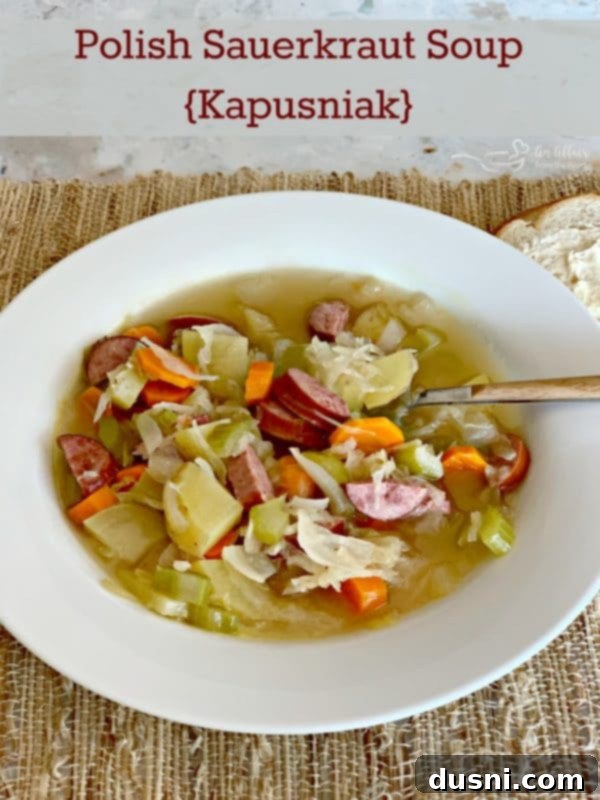
Ready to bring a taste of Polish tradition to your kitchen? Let’s get to the full recipe for my heartwarming Polish Sauerkraut Soup, Kapusniak!

LIKE THIS RECIPE?
Don’t forget to give it a ⭐️⭐️⭐️⭐️⭐️ star rating and
leave a comment below the recipe!

Print Recipe
Polish Sauerkraut Soup (Kapusniak)
Equipment
-
Franks Kraut, Shredded, Canned, 14-Ounce (Pack of 24)
-
AmazonBasics Enameled Cast Iron Covered Dutch Oven, 6-Quart, Blue
Ingredients
- 2 Tablespoons Olive Oil
- 1 bay leaf
- 2 cups Frank’s Kraut rinsed and drained
- 1 teaspoon caraway seed optional
- 1 pound Polska Kielbasa sliced
- 4 stalks celery chopped
- 3 carrots sliced
- 2 cups white potatoes diced (optional for low-carb)
- 2 32 ounce containers chicken stock
- 1/2 teaspoon pepper
- 1-2 teaspoons salt to taste (add after simmering)
- 1 small onion diced
Instructions
-
In a large Dutch oven or heavy-bottomed pot over medium-high heat, add the olive oil, bay leaf, and diced onion. Sauté for approximately 5 minutes until the onion is softened and translucent. Next, add the sliced kielbasa, kraut (which has been rinsed and drained), and caraway seeds (if using). Continue to cook for about 5 minutes, stirring frequently to combine the flavors. Finally, stir in the chopped carrots, celery, and diced potatoes, cooking and stirring occasionally for another 10 minutes to allow them to soften slightly.
-
Pour in the chicken stock, ensuring all ingredients are submerged. Bring the soup to a full boil, then reduce the heat to medium-low, cover the pot, and let it simmer gently for about 30 minutes, or until all the vegetables have reached your desired tenderness. The longer it simmers, the more the flavors will meld.
-
Remove the bay leaf. Taste the soup and season generously with salt and pepper as needed. Serve hot, accompanied by a hearty slice of fresh rye bread for dipping, which perfectly complements the rich flavors of this traditional Polish soup. Enjoy!
